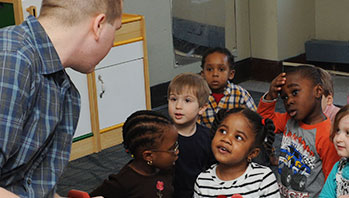- pictures of animals that are yellow
- construction paper (green and yellow)
- pom pom (yellow)
- bright
- color
- nature
- yellow
MA Standards:
Speaking and Listening/SL.PK.MA.1: Participate in collaborative conversations with diverse partners during daily routines and play.
Language/L.PK.MA.1: Demonstrate use of oral language in informal everyday activities.
Language/L.PK.MA.6: Use words and phrases acquired through conversations, listening to books read aloud, activities, and play.
Head Start Outcomes:
Language Development/Receptive Language: Attends to language during conversations, songs, stories, or other learning experiences.
Language Development/Expressive Language: Uses language to express ideas and needs.
Language Development/Expressive Language: Uses increasingly complex and varied vocabulary.
PreK Learning Guidelines:
English Language Arts/Language 2: Participate actively in discussions, listen to the ideas of others, and ask and answer relevant questions.
Talk Together: Yellow in Nature

© Commonwealth of Massachusetts, Department of Early Education and Care (Jennifer Waddell photographer). All rights reserved.
STEM Key Concepts: There are many different colors
ELA Focus Skills: Speaking and Listening, Vocabulary
Hold up different pictures of yellow animals in nature for children to discuss. Talk about why being the color yellow might help keep animals safe or unsafe. Tell children you are going to show them how it might be safe or unsafe for a butterfly to be the color yellow.
- Lay a large sheet of green construction paper on the floor and have children imagine it is a field of grass. Then hold up a yellow pom-pom and tell children to imagine it is a beautiful yellow butterfly.
- Place the “butterfly” on the “grass” and say, Do you think the yellow butterfly could hide in the grass if an animal was chasing it? Why?
- Now hold up the yellow sheet of paper and place it on the “grass” and say, Imagine this is a yellow blanket on the grass. Place the yellow “butterfly” on the yellow “blanket” and ask, Do you it would be easier for the butterfly to hide on the yellow blanket? Why?
Continue the discussion as you encourage children to think about other animals in nature and about how their color stands out or helps them hide.
- Call upon children’s prior knowledge about other yellow animals or insects.
- Ask questions such as, Why do you think it might it be good that some birds are a bright color like yellow?
